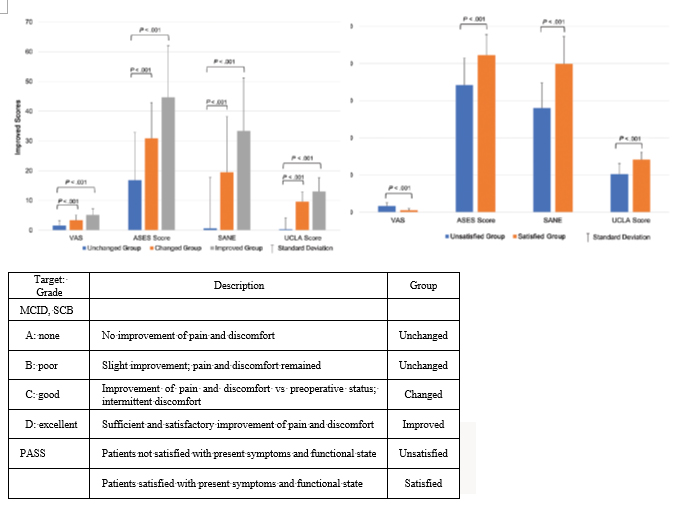- Greetings from the president
- Greetings
- Best Paper Awards
- The successful autumn academic conference in the amid of COVID-
- 2019 KSES American Traveling Fellow 연수기
- The 29th Annual International Congress of KSESr
- 의료칼럼: 3D navigation guided reverse shoulder arthroplasty
- 견슬라이더컵 골프대항전 대표선수 선발전 공지
- 학회 지난 소식들
- 회원동정
- 학회 신입회원 명단
2021 Korean Shoulder and Elbow Society (KSES) 'Current Trends and Issue.'
-
1. Kyoung-Hwan Koh, MD, PhD
: Asan Medical Center, University of Ulsan College of Medicine, Seoul
- ‘Minimal Clinically Important Difference, Substantial Clinical Benefit, and Patient Acceptable Symptomatic State After Arthroscopic Rotator Cuff Repair’ Am J Sports Med. 2020;48(11):2650-9. Go to page
“Minimal clinically important difference (MCID), substantial clinical benefit (SCB), and patient acceptable symptomatic state (PASS) are emerging criteria for patient-based treatment assessments.
The purpose of this study are (1) to determine MCID, SCB, and PASS values for pVAS, SANE, ASES score, and UCLA score after arthroscopic rotator cuff repair (2) to determine factors for achieving the MCID, SCB, and PASS.
Eighty-two patients (Mar.2018~Feb.2019) were included, and anchor questions for deriving MCID, SCB, and PASS values were applied at 1-year follow-up after the surgery. Additionally, univariable and multivariable logistic regression analyses were performed to determine factors for achieving the MCID, SCB, and PASS.
MCID, SCB, and PASS values for the pVAS were 1.5, 2.5, and 1.7; for ASES scores, 21.0, 26.0, and 78.0; for SANE, 13.0, 20.0, and 71.0; and for UCLA scores, 6.0, 8.0, and 23.0, respectively. Poor preoperative scores demonstrated significantly higher odds ratios (ORs) for achieving the MCID and SCB and lower ORs for achieving the PASS. Retear, large to massive tear, and older age showed lower ORs for achieving the MCID or SCB. For PASS items, male sex and biceps tenodesis had higher ORs, and older age had lower ORs.
Reliable MCID, SCB, and PASS values were obtained from patient evaluations 1 year after arthroscopic rotator cuff surgery.”

-
2. Chris Hyun-chul Jo, MD, PhD
: SMG-SNU Boramae Medical Center, Seoul National University College of Medicine, Seoul
- ‘Regeneration of the rotator cuff tendon-to-bone interface using umbilical cord-derived mesenchymal stem cells and gradient extracellular matrix scaffolds from adipose tissue in a rat model.’ Acta Biomater. 2020;114:104-16. Go to page
“Despite satisfactory outcomes after rotator cuff repair, regeneration of the gradient structure of the tendon-to-bone interface (TBI) is one of crucial unsolved problems yet.
Biomimetic scaffolds have emerged as a promising approach for regenerating the rotator cuff structure, and selection of cells has been also an essential part for consideration. The purpose of this study was to investigate the efficacy of a biomimetic hydroxyapatite-gradient scaffold (HA-G scaffold) isolated from adipose tissue with umbilical cord derived mesenchymal stem cells (UC MSCs) on the regeneration of the structure of the TBI by analyzing the histological and biomechanical changes in a rat repair model.
In this study, we found tendon, cartilage and bone formation in the corresponding compartment of HA-G-scaffold and identified improved histological and biomechanical results of repaired rotator cuff. The most important significance of this study would be that USC MSCs in the HA-G-scaffold formed expected tissues without any additional stimuli for regeneration which suggest its potential for rapid clinical translation.”
Clinics in Shoulder and Elbow (CiSE) Hot Topics for Research
-
1. Chul-Hyun Cho, MD, PhD
: Keimyung University Dongsan Hospital, Keimyung University School of Medicine, Daegu
- ‘Primary Total Elbow Replacement for Treatment of Complex Distal Humerus Fracture: Outcomes of Short-term Follow-up.’ Clin Shoulder Elb. 2020;23(1):20-6. Go to page
“The purpose of this study was to investigate the short-term outcomes and complications after primary TER in patients with complex distal humerus fracture. Nine patients (mean age : 72.7 years) with acute fracture were treated by primary TER for using the semi-constrained Coonrad-Morrey prosthesis.
The mean VAS pain score, MEPS, and Quick-DASH at the mean follow-up of 29 months were 1.2, 80.5, and 20, respectively. The mean ROM was 127.7o of flexion, 13.8o of extension, 73.3o of pronation, and 74.4o of supination. And there was no evidence of bushing wear or high-grade implant loosening on the serial plain radiographs.
Our study demonstrated that primary TER produce satisfactory short-term functional and radiographic outcomes in patients with complex distal humerus fractures. However, we found 3 complications (33.3%) out of 9 cases including 2 periprosthetic fractures and 1 ulnar neuropathy that need secondary operation. The patient with progressive ulnar neuropathy was recovered completely after adhesiolysis and decompression of the ulnar nerve at 5 months after TER, but 2 patients with periprosthetic fracture were treated with ORIF and unsatisfactory clinical outcomes at the final follow-up. In terms of TER indication, we believe that primary TER for complex distal humerus fractures should be selected carefully based on patient’ age, bone quality, comorbidities, soft tissue condition as well as intra-articular comminution because of considerable postoperative complications.
In conclusions, primary TER for the treatment of complex distal humerus fractures in elderly patients yielded satisfactory short-term outcomes. However, the surgeons should consider high complication rate after primary TER.”



